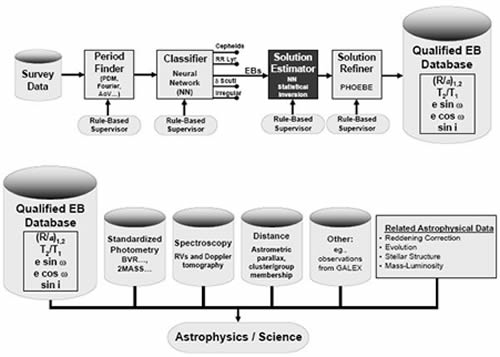EB Factory
The goal of EB Factory is to develop an end-to-end computational pipeline that allows automatic processing of massive amounts of light curve data--from period finding, to object classification, to determination of the stellar physical properties--in order to find the most scientifically interesting eclipsing binaries (EBs) and to permit accurate modeling of these EBs for detailed tests and benchmarking of theoretical stellar evolution models.
We are integrating the most successful algorithms into a single, cohesive workflow environment, and are applying this ‘EB Factory’ to the full public Kepler dataset to find and characterize new “benchmark grade” EBs, and will disseminate both the enhanced data products from this pipeline and the pipeline itself to the broader NASA science community, especially other Kepler mission researchers.
More generally, we are developing the EB Factory as a flexible, open source, modular framework in order to permit simple modifications by other users for a wide array of other types of variable stars of interest, such as RR Lyraes.
The EB Factory source code can be accessed at this github repository.

EB Factory is conceptually an “assembly line” in which light curve data go into the “hopper” (left side, top row of the figure) and are passed through a series of processing steps. All of the light curve data can be fed to the Factory with no a priori knowledge about the nature of the stars. The first task is to determine whether the light curve exhibits periodic behavior (for EBs this is not as simple as it sounds!). For those objects determined to be periodic, the next step is to classify them. Many different types of stars exhibit periodic variability due to a variety of phenomena (e.g. Cepheids, RR Lyrae, Scuti stars), therefore this classification is likelihood-based so that the user can decide appropriate confidence thresholds, depending on the user’s needs for sample completeness versus fidelity. Objects determined to be high likelihood EBs are then passed to a neural net or genetic algorithm based “solution estimator” that estimates the underlying physical properties of the EBs (i.e. stellar dimensions, temperatures, etc). Obviously the estimator does just that, so the resulting stellar properties are not highly accurate. However, the goal is that the estimated properties are sufficient for identifying the most scientifically “interesting” EBs. The incorporation of ancillary data from external catalogs specifically helps here to further narrow down the likely nature of the EBs. The most interesting EBs are then subjected to intensive analysis with the Solution Refiner (which is computationally expensive), and follow-up observations obtained to fully characterize the EB.